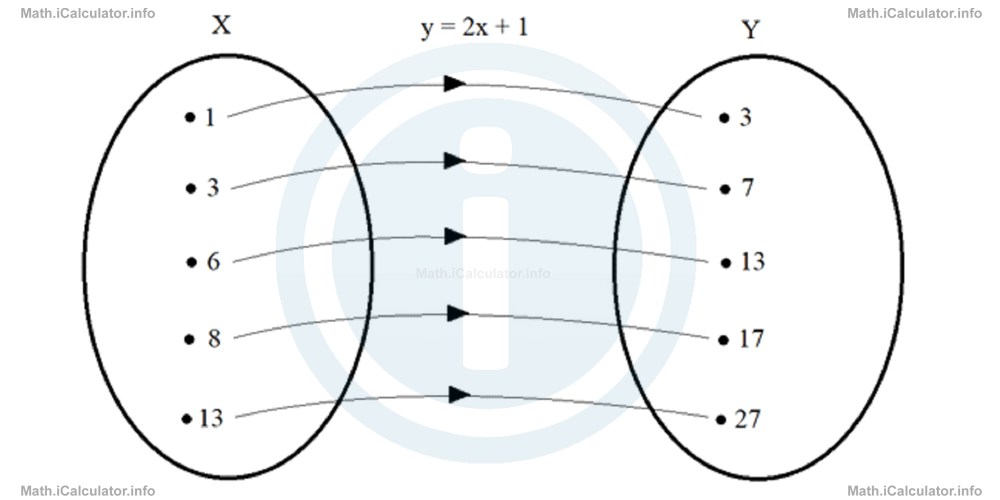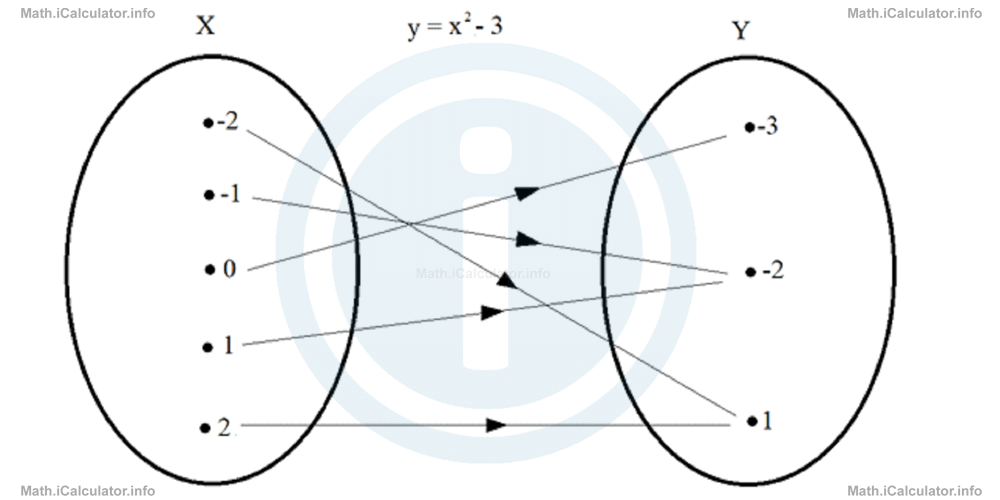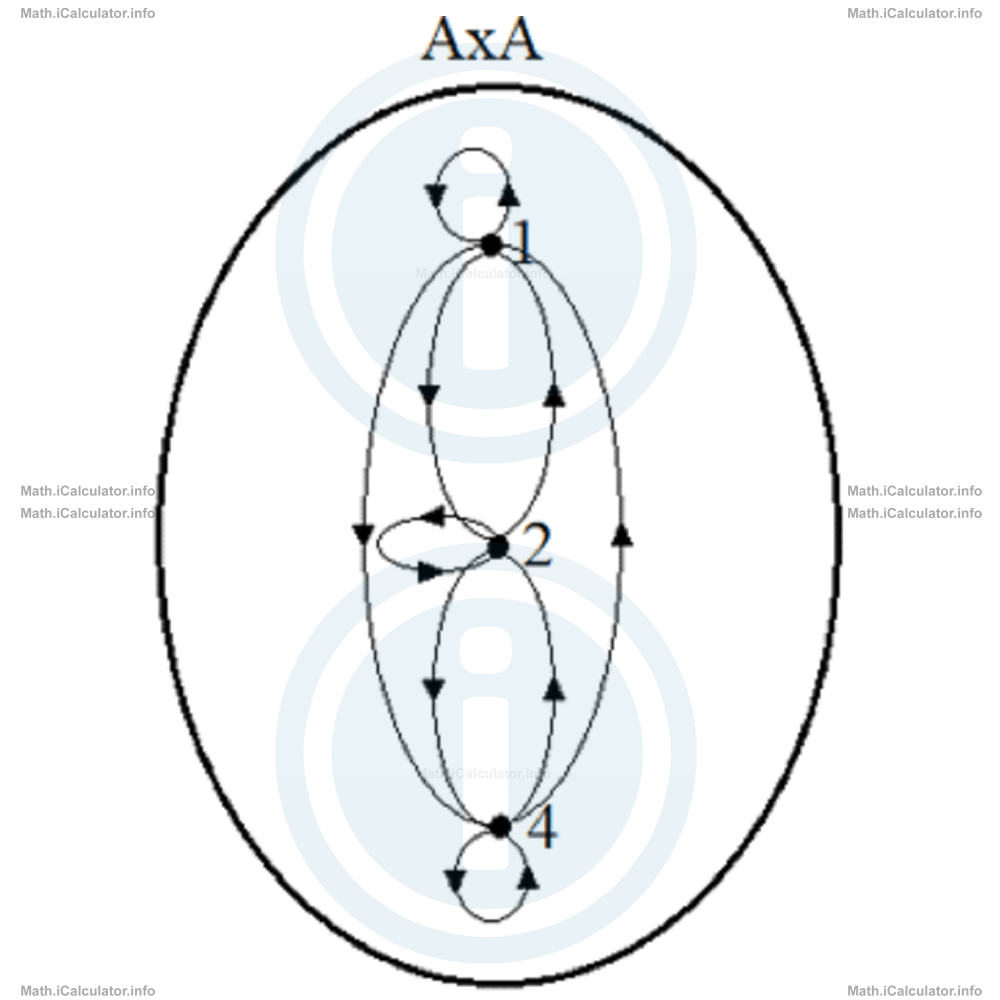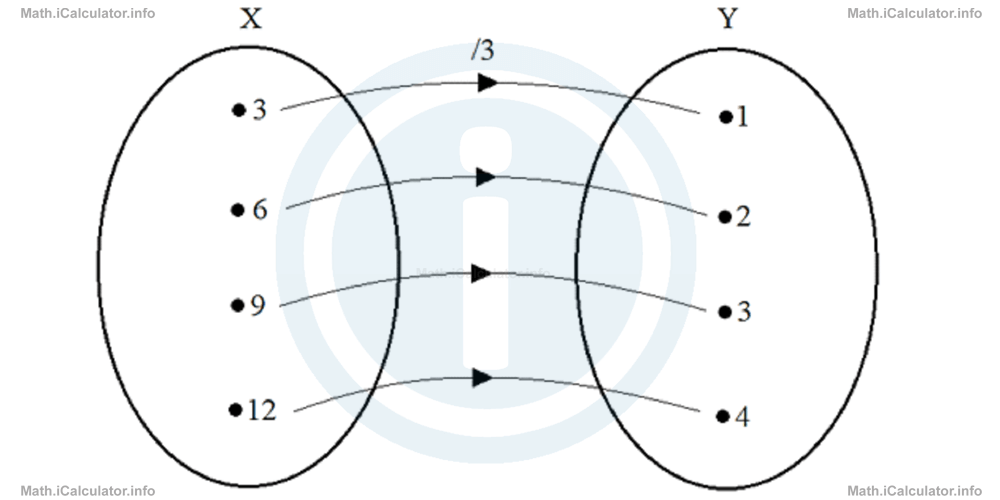Menu
Math Lesson 16.1.5 - Representing Relations
Please provide a rating, it takes seconds and helps us to keep this resource free for all to use
Welcome to our Math lesson on Representing Relations, this is the fifth lesson of our suite of math lessons covering the topic of Relation and Function, you can find links to the other lessons within this tutorial and access additional Math learning resources below this lesson.
Representing Relations
There are a number of ways to describe the relations. Each of these ways (methods) has its own advantages and disadvantages and is more suitable in a particular context. These methods are described below.
a) Venn Diagram Method
Sometimes - especially when the elements from the input and output sets are finite - relations are shown through diagrams (more precisely through Venn diagrams), which are tools used to visually describe the similarities, differences and types of connections between the elements of two number sets: input and output. A Venn diagram is a kind of circle or ellipse, where the elements are spread out in the inner part, as shown in the figure below.

In other words, a Venn diagram uses overlapping circles or other shapes to illustrate the logical relationships between two or more sets of items. Often, they serve to graphically organize things, highlighting how the items are similar and different.
This method of representing relations can be used in sets where the number of input elements is not equal to that of output ones, like in the example below.
A relation may occur in elements of the same set as well. For example, we can express the Cartesian square discussed in the previous paragraph through Venn diagram as below.

b) Set Builder Method
In this method of expressing relations, we use mathematical notation (symbols) to describe the combination of elements of the two sets (input X and output Y) according to a pre-defined rule. All conditions required to express the relation are written one after another separated by a comma. Before providing examples, let's give the meaning of some math symbols used in the set builder method.
The symbol "∊" means "is an element of ". It is used to describe situations in which an element (number) belongs to a number set. For example, "3 ∊ A" means "the number 3 is an element of the number set A".
The symbol "⊂" means "is a subset of ". It is used to describe situations in which a smaller set is part (subset) of a larger set of numbers. For example, if A = {3, 6, 9} and B = {0, 3, 6, 9, 12} we write A ⊂ B, as all elements of A belong to B and the latter has more elements not contained in A.
The symbol "⋀" means "and". It is used when two conditions apply simultaneously to a given situation. For example, if we have A = {natural numbers smaller than 10 ⋀ divisible by 3}, it is obvious that A = {3, 6, 9} because the two above conditions must apply simultaneously.
The curled brackets {} are used to describe number sets, as shown in the above examples.
Recall from the first chapter of this course the letters used to represent various number sets. Thus, N stands for natural numbers (counting numbers from 1 and on); W stands for whole numbers (all natural numbers including zero); Z stands for integers (positive and negative whole numbers including zero); Q stands for rational numbers (fractions); I for irrational numbers (those that cannot be written as fractions) and R stands for real numbers (rational & irrational ones).
For example, the relation R = {x ∊ N, y ∊ N, x < 6, y = xx - 1} represents the relation between the two sets X = {1, 2, 3, 4, 5} and Y = {0, 3, 8, 15, 24}. This is because both sets X and Y have natural numbers where those of X are smaller than 6 and all the corresponding y-values are obtained by raising in square each element of the set X and subtracting 1 from the result.
Example 5
Two sets: X = {3, 6, 9, 12} and Y = {1, 2, 3, 4} form a relation between them where the first element of the first set is connected to the first element of the second set and so on.
- Identify the relation (the rule) that connects the elements of the two sets.
- Express the relation using the Venn diagram method.
- Express the relation using the set builder method.
Solution 5
- It is easy to see that the elements of the second set are obtained by dividing by 3 the corresponding elements of the first set. Therefore, the rule that identifies this relation is y = x/3
- The following figure expresses the above relation using the Venn diagram method.

- We see that the elements of the set X are the first four natural numbers that are divisible by 3, while those of the set Y are simply the first four natural numbers. Therefore, we describe this relation through the set builder method as follows:R(X, Y) = {x ∊ N, y ∊ N, x ≤ 12, y ≤ 4, x ⋮ 3, y = x/3}
c) Roster Method (Form)
Roster form is the simplest method for representing relations. In this method, all elements of the relation are listed inside a set of brackets, where all the possible ordered pairs of the two sets that follow the given relation are written. Earlier in this tutorial we used this form of presentation (albeit not in a relation) when listing all possible ordered pairs produced by a Cartesian product.
For example, the relation in Example 5, when expressed in the roster form becomes
From all the above methods, the set builder method is the most suitable, as it allows representation in all relations regardless of the number of elements the input and output sets may have. In other words, this method allows representing relations with a very large or even infinite number of elements, unlike the other two methods, which are used only when the number of elements participating in a mathematical relation is limited.
For example, the relation R(X, Y) = {x ∊ N, y ∊ N, y = 2x - 1} contains an infinite number of ordered pairs, as the set X contains all natural numbers (which have no end). As a result, the set Y is also infinite. Therefore, we cannot represent this relation using the Venn diagram method, as the diagrams would be with infinite dimensions to include all values. The same thing is also true for the roster method, where we are supposed to list all possible ordered pairs produced by the relation. Obviously, it is impossible to list an infinite number of ordered pairs.
You have reached the end of Math lesson 16.1.5 Representing Relations. There are 9 lessons in this physics tutorial covering Relation and Function, you can access all the lessons from this tutorial below.
More Relation and Function Lessons and Learning Resources
Whats next?
Enjoy the "Representing Relations" math lesson? People who liked the "Relation and Function lesson found the following resources useful:
- Represent Feedback. Helps other - Leave a rating for this represent (see below)
- Functions Math tutorial: Relation and Function. Read the Relation and Function math tutorial and build your math knowledge of Functions
- Functions Revision Notes: Relation and Function. Print the notes so you can revise the key points covered in the math tutorial for Relation and Function
- Functions Practice Questions: Relation and Function. Test and improve your knowledge of Relation and Function with example questins and answers
- Check your calculations for Functions questions with our excellent Functions calculators which contain full equations and calculations clearly displayed line by line. See the Functions Calculators by iCalculator™ below.
- Continuing learning functions - read our next math tutorial: Injective, Surjective and Bijective Functions. Graphs of Functions
Help others Learning Math just like you
Please provide a rating, it takes seconds and helps us to keep this resource free for all to use
We hope you found this Math tutorial "Relation and Function" useful. If you did it would be great if you could spare the time to rate this math tutorial (simply click on the number of stars that match your assessment of this math learning aide) and/or share on social media, this helps us identify popular tutorials and calculators and expand our free learning resources to support our users around the world have free access to expand their knowledge of math and other disciplines.